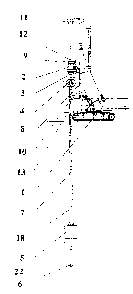Some of the information on this Web page has been provided by external sources. The Government of Canada is not responsible for the accuracy, reliability or currency of the information supplied by external sources. Users wishing to rely upon this information should consult directly with the source of the information. Content provided by external sources is not subject to official languages, privacy and accessibility requirements.
Any discrepancies in the text and image of the Claims and Abstract are due to differing posting times. Text of the Claims and Abstract are posted:
| (12) Patent Application: | (11) CA 2365005 |
|---|---|
| (54) English Title: | DRILL FOR MAKING WIDE DIAMETER AND HIGH DEPTH HOLES AND METHOD FOR CARRYING OUT SAID HOLES |
| (54) French Title: | TREPAN PERMETTANT DE PRATIQUER DES TROUS PLUS LARGES ET PLUS PROFONDS ET PROCEDE AFFERENT |
| Status: | Deemed Abandoned and Beyond the Period of Reinstatement - Pending Response to Notice of Disregarded Communication |
| (51) International Patent Classification (IPC): |
|
|---|---|
| (72) Inventors : |
|
| (73) Owners : |
|
| (71) Applicants : |
|
| (74) Agent: | BORDEN LADNER GERVAIS LLP |
| (74) Associate agent: | |
| (45) Issued: | |
| (86) PCT Filing Date: | 2000-03-11 |
| (87) Open to Public Inspection: | 2000-09-14 |
| Availability of licence: | N/A |
| Dedicated to the Public: | N/A |
| (25) Language of filing: | English |
| Patent Cooperation Treaty (PCT): | Yes |
|---|---|
| (86) PCT Filing Number: | PCT/IB2000/000261 |
| (87) International Publication Number: | WO 2000053882 |
| (85) National Entry: | 2001-09-10 |
| (30) Application Priority Data: | ||||||
|---|---|---|---|---|---|---|
|
A drill for drilling wide diameter and high depth holes in the soil including
a base machine (1) having a rotary (2) that is equipped with a clamp (9) and,
by means of translation cylinders (8), rotates and axially moves a series of
drill stem (7) having a tool (6) at the free end thereof, includes: a
hydraulic joint (3) linked to the rotary (2); at leat a winch (4) linked to
the hydraulic joint (3) and provided with at least a wire rope (18); a carrier
canister (5) slidely connected with the stem (7) between the rotary (2) and
the tool (6) by means of at least the wire rope (18); at least a winch (4), a
wire rope (18), a carrier canister (5) are rotated together with the stem (7)
of the rotary (2) in correspondence of an operating condition of the drill.
L'invention concerne un trépan permettant de pratiquer des trous plus larges et plus profonds dans le sol, le trépan comprenant une machine (1) de base dotée d'un élément rotatif (2) équipé d'une bride de serrage (9) et qui, grâce à des cylindres (8) de translation, effectue une rotation et déplace dans l'axe une série de trains de tiges (7) de forage comportant un outil (6) à leur extrémité libre, la machine de base comprenant : - un joint (3) hydraulique relié à l'élément rotatif (2) ; - au moins un treuil (4) relié au joint (3) hydraulique et comprenant au moins un câble métallique (18) ; - un contenant (5) de transport relié coulissant au train de tiges (7),entre l'élément rotatif (2) et l'outil (6), au moyen du câble métallique (18) ; le treuil (4), le câble métallique (18) et le contenant de transport (5) effectuant un mouvement de rotation en même temps que le train de tiges (7) de l'élément rotatif (2) pendant le fonctionnement du trépan.
Note: Claims are shown in the official language in which they were submitted.
Note: Descriptions are shown in the official language in which they were submitted.

2024-08-01:As part of the Next Generation Patents (NGP) transition, the Canadian Patents Database (CPD) now contains a more detailed Event History, which replicates the Event Log of our new back-office solution.
Please note that "Inactive:" events refers to events no longer in use in our new back-office solution.
For a clearer understanding of the status of the application/patent presented on this page, the site Disclaimer , as well as the definitions for Patent , Event History , Maintenance Fee and Payment History should be consulted.
| Description | Date |
|---|---|
| Time Limit for Reversal Expired | 2005-03-11 |
| Application Not Reinstated by Deadline | 2005-03-11 |
| Deemed Abandoned - Failure to Respond to Maintenance Fee Notice | 2004-03-11 |
| Letter Sent | 2002-11-04 |
| Inactive: Single transfer | 2002-09-05 |
| Inactive: Entity size changed | 2002-03-20 |
| Inactive: Cover page published | 2002-02-05 |
| Inactive: Courtesy letter - Evidence | 2002-02-05 |
| Inactive: Notice - National entry - No RFE | 2002-01-31 |
| Inactive: First IPC assigned | 2002-01-31 |
| Application Received - PCT | 2002-01-16 |
| Amendment Received - Voluntary Amendment | 2001-09-11 |
| Application Published (Open to Public Inspection) | 2000-09-14 |
| Abandonment Date | Reason | Reinstatement Date |
|---|---|---|
| 2004-03-11 |
The last payment was received on 2003-03-11
Note : If the full payment has not been received on or before the date indicated, a further fee may be required which may be one of the following
Please refer to the CIPO Patent Fees web page to see all current fee amounts.
| Fee Type | Anniversary Year | Due Date | Paid Date |
|---|---|---|---|
| Basic national fee - small | 2001-09-10 | ||
| MF (application, 2nd anniv.) - standard | 02 | 2002-03-11 | 2002-03-11 |
| Registration of a document | 2002-09-05 | ||
| MF (application, 3rd anniv.) - standard | 03 | 2003-03-11 | 2003-03-11 |
Note: Records showing the ownership history in alphabetical order.
| Current Owners on Record |
|---|
| I.M.T. S.P.A. |
| Past Owners on Record |
|---|
| GIULIO ACCORRONI |